Ever wondered how long the ball is actually in-play during a football match?
You may be surprised.
It's a scenario being played out on every football pitch from Wembley Stadium to the Sunday leagues.
A team is leading the match by a single goal and their players are rolling around feigning injury or taking an age to take a goal kick, safe in the knowledge that the referee will never add on the exact amount of time they have wasted to the match time.
Teams make a substitution in the final minute and a player, perfectly fit until that time, walks off at the pace of a pensioner who's run a marathon, stopping to shake hands with everyone and turning to applaud the fans in all corners of the stadium. A smile creeps across their face as they leave the field knowing that every second over the official 30-second allowance for a substitution is a second the opposition will never get back. Job done.
As these time-wasting tactics become ever more prevalent and sophisticated, many senior officials in the game as well as a number of senior professional players are beginning to question whether a radical change to the match structure should be introduced to combat these tactics and clarify exactly how much playing time remains.
To highlight the amount of time where the ball is actually 'in-play', Falu Studios tracked matches at the 2018 FIFA World Cup™ in order to build a set of infographics for match and tournament statistics and provide answers to the following questions.
- How many minutes of a typical top-level football match are spent with the ball in play?
- Does the additional time added on by the referee accurately represent the lost time in a match?
- Would a change to a 'play clock' format be beneficial to the game?
If you would prefer a standalone article solely on the stoppage time discrepancies, you can read our companion piece 'A Lapse in Stoppage Time'.
The FIFA World Cup™ is a tournament between, currently, 32 national teams playing a combination of group and knockout matches, resulting in a total of 64 matches over the course of approximately a calendar month.
The nature of the tournament means that a wide variety of scenarios are played out within a small sample of matches. Early group matches can be highly competitive, later ones can be very edgy and nervy. Huge underdogs take on the giants of the sport simply trying to avoid defeat. Tactical squad rotations and points predictions affect team selection in the final group matches. In the knockout stages teams decide whether to push for a win, play defensively and hope for the best or 'park the bus' and wait for penalties.
1
THE IN-PLAY CONUNDRUM
A look at the amount of time the ball was actually 'in-play' during each match at the 2018 FIFA World Cup™
Each bar on the chart represents a match at the tournament. Blue bars show matches during the group stages and orange bars show knockout matches. Grey bars indicate the actual duration of the half. The red line shows the 30-minute mark at which the play clock format would terminate the half. Click or tap a bar to view the match details.
THE IN-PLAY CONUNDRUM
A look at the amount of time the ball was actually 'in-play' during each match at the 2018 FIFA World Cup™
Each bar on the chart represents a match at the tournament. Blue bars show matches during the group stages and orange bars show knockout matches. Grey bars indicate the actual duration of the half. The red line shows the 30-minute mark at which the play clock format would terminate the half. Click or tap a bar to view the match details.
Analysis
By looking at all 128 halves of normal time across the tournament, it is clear that irrespective of the type of match, the importance of the result or the teams involved, the actual time where the ball is in-play is fairly stable, fluctuating gently around the 30-minute mark and averaging out at 28:06 per half.
|
28:06 Average In-play Half |
||
|
28:16 Average In-play 1st Half |
27:56 Average In-play 2nd Half |
56:12 Average In-play Match |
The 30-minute line clearly shows that there were hardly any halves that exceeded this amount of action so in most cases fans would get to see more action under the play clock format.
It is also clear just how much of any given match is taken up by dead time where the ball is not actively in play. The knockout matches may be marginally more active as expected but in general there is no definitive difference between the in play times across all matches.
Despite the 2nd halves routinely being of longer duration, the in play times do not increase.
A look at the extremes
Most matches had in-play halves of between 27 and 31 minutes and match times around the 60-minute mark however some extreme situations stood ought as shown here.
 Shortest In-Play Half France v Croatia 1st Half With a penalty that took over 5 minutes off the clock plus two other goals and a tournament high 61 stoppages in total, it is a testament to the intensity of the occassion that fans barely noticed how little time the ball was in play due to the unusual amount of action the half contained compared to recent finals. Under a play clock system those fans would have been treated to 10 extra minutes of this absorbing match. |
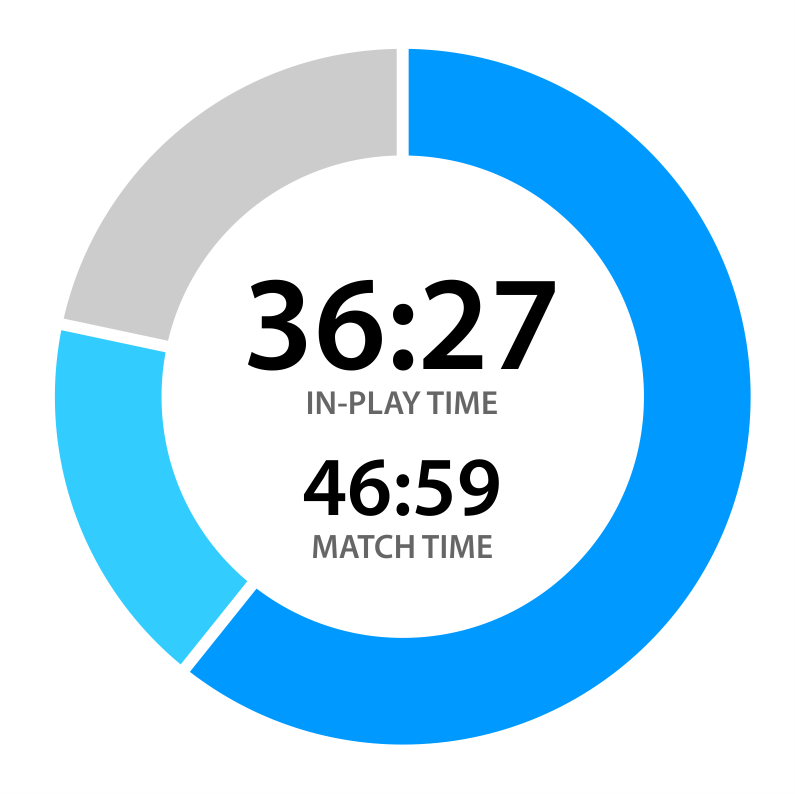 Longest In-Play Half Belgium v England 1st Half This statistic sits neatly alongside the general theory that this match between two nations already out of the tournament is a largely meaningless affair more akin to a friendly match. Both teams are having to perform whilst overshadowed by the enormous disappointment of missing out on a place in the final. Belgium dominated the match and passed the ball around at ease with no serious pressure applied by England, leading to a routine, effortless victory. |
 Shortest In-Play Match Morocco v Iran We will have a closer look at this match further down the page. |
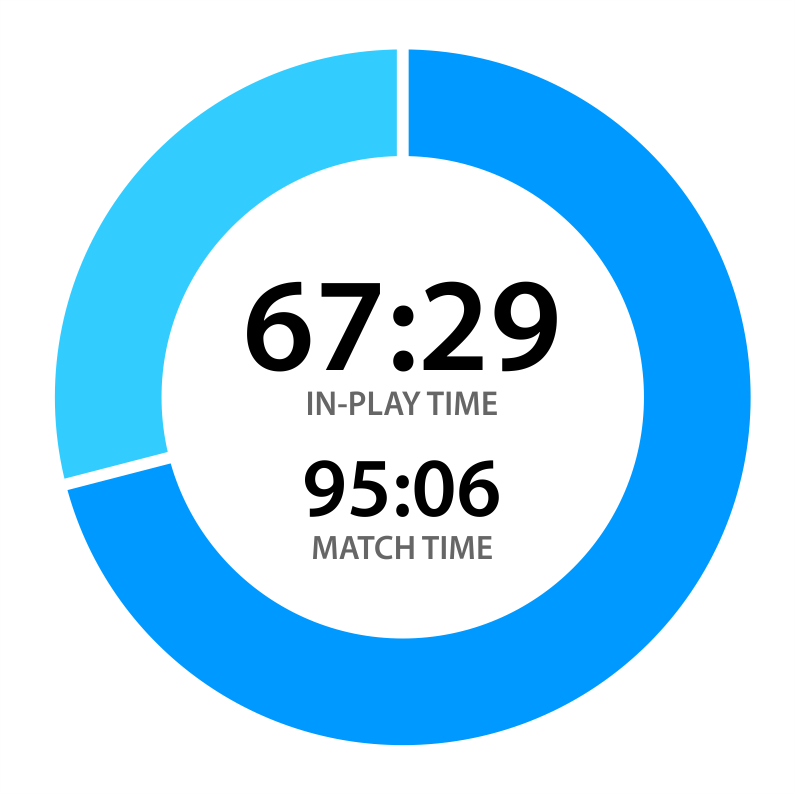 Longest In-Play Match Belgium v England |
 Halves with less than 25 minutes play |
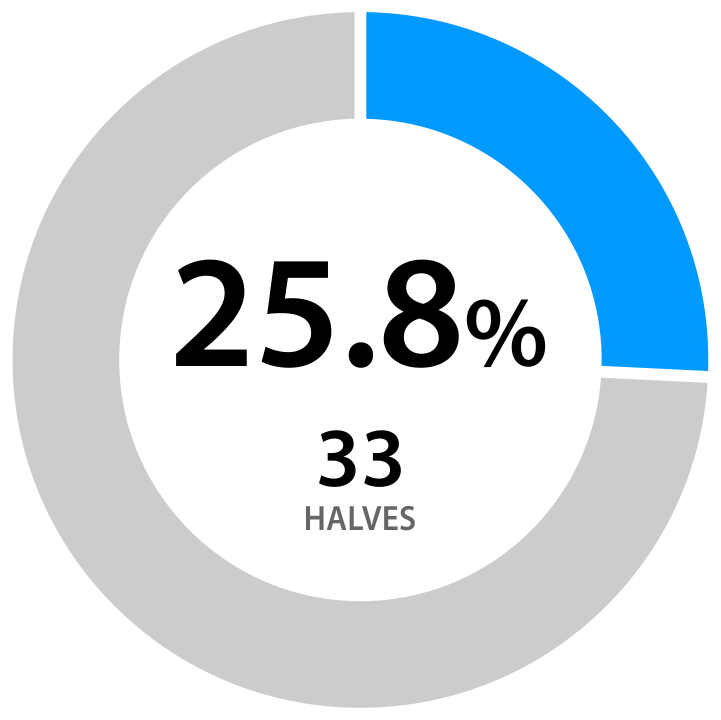 Halves with more than 30 minutes play |
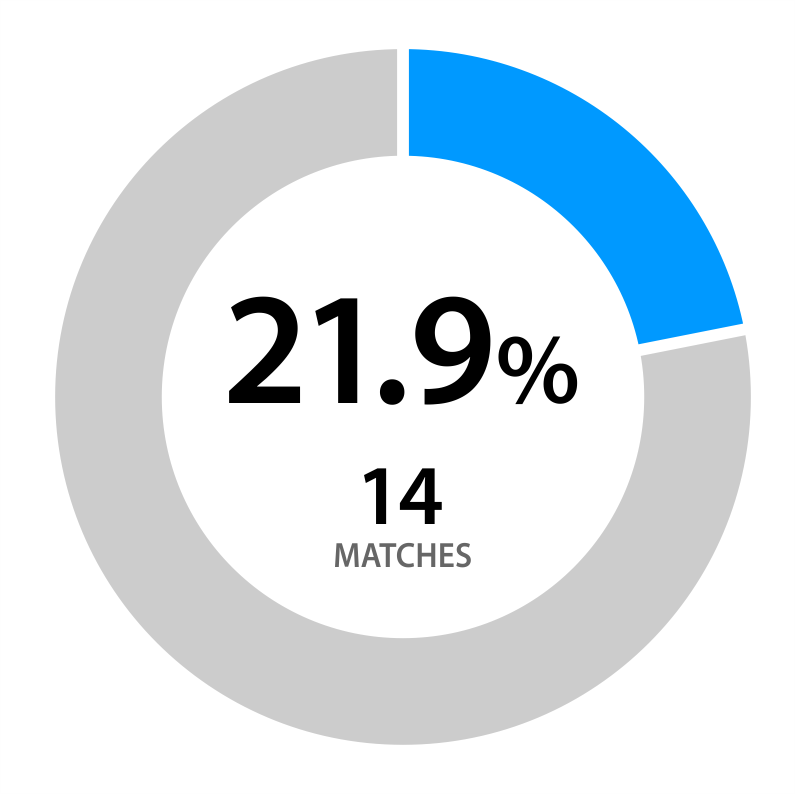 Matches with more than 60 minutes play |
Our definition of a stoppage
Only official stoppages were noted such as free kicks, corners, goal kicks, throw-ins, injury stoppages, goal celebrations, penalties, VAR referrals and stoppages that included a substitution. Delays to the game instigated by players whilst the ball is in play were not counted, such as a goalkeeper taking excessive time to redistribute the ball or teams killing time with needless passes or holding the ball at the corner flag.
Timings were taken from official match footage and the best estimates used where a stoppage or restart went unseen by the broadcast. Free kick stoppages commenced with the referee's whistle, irrespective of the timing of the foul, and ended when the free kick is taken.
For the purpose of calculating the in-play time, the entire duration of the half was analysed from the opening kick-off to the end of any added time. For analysing the stoppage time discrepancies, only definitive stoppages within the 45 minutes are included since the reference point is the amount of time the referee chooses to add at the 45-minute mark.
2
THE ADDED TIME DISCREPANCY
A look at the added time assigned by the referee in relation to the definitive stoppages during the half
Each bar on the chart represents a match at the tournament. Black lines indicate the actual maximum added time indicated by the referee at the end of normal time. The bars indicate the difference between the referee's time and the definitive stoppages in the half that should have been accounted for in the very least.
Blue bars show matches during the group stages and orange bars show knockout matches. Lighter bars represent a half where the referee's time was sufficient, darker bars indicate a half where the added time was insufficient. Click or tap a bar to view the match details.
THE ADDED TIME DISCREPANCY
A look at the added time assigned by the referee in relation to the definitive stoppages during the half
Each bar on the chart represents a match at the tournament. Black lines indicate the actual maximum added time indicated by the referee at the end of normal time. The bars indicate the difference between the referee's time and the definitive stoppages in the half that should have been accounted for in the very least.
Blue bars show matches during the group stages and orange bars show knockout matches. Lighter bars represent a half where the referee's time was sufficient, darker bars indicate a half where the added time was insufficient. Click or tap a bar to view the match details.
"Additional time is mostly one minute in the first half and three minutes in the second half. In a match in which many goals have been scored, the celebration of a goal often takes a lot of time, so this should be added"
Marco van Basten, 2017
Analysis
Current legislation allows the referee to determine how long a half lasts by adding on time for definitive stoppages during the half, with the current format allowing natural stoppages, such as free kicks and corners, as well as injury stoppages and substitutions to take time off the clock but surely penalties, goal celebrations and VAR referrals should be added to the duration of the half as well.
In almost all cases, referees do not add the correct amount of time to the clock to take account of these clear breaks in play, thereby discriminating against any team needing a fair amount of match time to seek the required result.
In 2017, FIFA™ ordered referees to include goal celebration time in stoppage time and in the week before the start of the 2018 FIFA World Cup™ they stated that VAR referrals would be fully added to stoppage time for each half.
Clearly neither of these orders were carried out.
We notice that the first halves generally have the definitive stoppages accounted for by the added time. This may be partially due to the unlikely event of a first half substitution, fewer goals scored and the reduced requirements for time-wasting early in the match.
However, in the second halves, almost 75% of all matches failed to account for these clear stoppages. Remember we are only taking account of clear, obvious breaks in play and not even noting normal stoppages.
The difference in randomness between the added time and the definitive stoppages further backs up the suggestion that referees are guessing added time or following a set model, even taking account of the lack of precision required on the part of the referee when indicating the maximum time being allocated.
Despite almost 83% of second halves having more than 4 minutes of basic stoppages, almost 63% were allocated a maximum of 4 minutes added time.
42% of second halves were allocated an added time of 4 minutes, irrespective of the fact that these 27 halves had a spread of definitive stoppages ranging from 2:27 to 8:45.
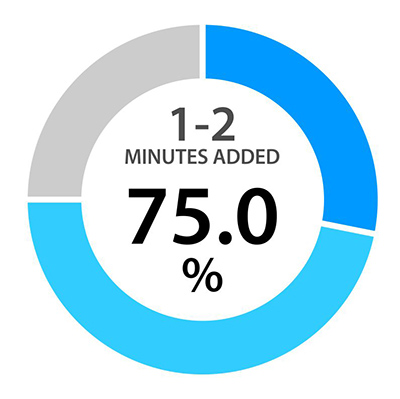 1st Half Added Time |
 2nd Half Added Time |
A look at the extremes
Of the 128 halves of football that made up the normal time periods of the 2018 FIFA World Cup™, 107 had at least one stoppage for a goal, a penalty, a VAR/GLT referral or a stoppage that involved a substitution.
Of those 107 halves, 71 had an amount of injury time added by the referee that did not even cover these definitive stoppages, let alone any genuine injuries or time-wasting tactics.

Three halves had definitive stoppages (goal/penalty/VAR/substitution) of more than 10 minutes with the combined time lost being 31:22. The injury time added by the referees for these three halves was 13:00 which should not only account for these stoppages but also take account of injuries, meaning a total of more than 18 minutes of genuine stoppages were ignored by the referee in just these three halves.
In two of these cases, the lengthy definitive stoppage time was in part caused by the use of VAR. FIFA™ long opposed this technology based on the perceived interruption to the flow of the game yet now they have succumbed to pressure, they forget to account for the delay in the added time on the half.
The other case involved an extraordinary half where England put five goals past Panama, including two penalties, which meant that around 5 minutes of the half was simply lost to goal celebrations. In this case it hardly mattered since all the goals were scored by one team, but what if the half ended 3:2 with 5 minutes lost? Would the losing team feel aggrieved?
In addition, the Iran v Portugal match had 3:22 lost to VAR, a penalty and a goal during the six minutes added at the end of the second half. The referee increased the added time by just over a minute.
The late goal dilemma
When you are drawn into a group featuring 2010 World Champions Spain and 2016 European Champions Portugal, you are already in trouble. A quirk of the draw meant that the two heavyweights in the group would play each other in the opening game, leaving the two underdogs playing each other with matches against the big boys to come later.
In this scenario, losing to your fellow underdog almost certainly condemns you to an early exit from the tournament.
With this in mind, Morocco and Iran played out a match with lengthy stoppages and numerous unnecessary delays at throw-ins, goal kicks and free kicks. The Iranian players in particular taking an age to restart the game at every opportunity.
Some will say this is time-wasting and a little underhand, others will claim it is superb time management and the best way to try to survive the match. There are sufficient arguments to back up both sides of the discussion.
Irrespective of which side of that particular fence you sit, the Iranian tactics worked when they benefitted from an unfortunate Moroccan own goal in the dying minutes of added time and took a 1-0 victory. Morocco were afforded just 39 seconds after the restart to get an equaliser in accordance with the 6 minutes of added time being played.
When the goal went in, an amazing 51:07 had been used up without the ball actually being in play, eventually resulting in Morocco having little time left to respond to the goal. So how would a match like this be different under a play clock? The graphic below demonstrates how time-wasting tactical advantages are reduced by the play clock format.

A similar scenario is played out in almost all matches where there is a late goal that alters the result, including Saudi Arabia v Egypt, Nigeria v Argentina, Serbia v Switzerland to name but a few. Incredibly, this scenario played out in 4 out of the 6 matches in the group we have discussed here with Morocco v Iran, Iran v Portugal, Spain v Morocco and Portugal v Spain all having the result altered by a late goal that may not have been quite so late under a play clock.
Of course, even with the play clock there would be late goals with no time for a response but at least it wouldn't benefit a team who have done nothing more than manage the clock.
3
THE HALF-HOUR HALF
A look at a radical shake-up of the format of a match
The main circular graphics below represent each half of the chosen match and indicate the occurence and timing of each stoppage with different colours indicating different types of stoppages. The grey segment indicates the actual in-play time for the duration of the half and is used to determine how much playing time would remain using the play clock format.
Definitive stoppages (goal celebrations, penalty taking, VAR/GLT referrals and substitutions) are those that clearly waste time and ought to be fully accounted for by the referee when assessing the added time for the half.
Select a match from the drop menu below to view the data.
THE HALF-HOUR HALF
A look at a radical shake-up of the format of a match
The main circular graphics below represent each half of the chosen match and indicate the occurence and timing of each stoppage with different colours indicating different types of stoppages. The grey segment indicates the actual in-play time for the duration of the half and is used to determine how much playing time would remain using the play clock format.
Definitive stoppages (goal celebrations, penalty taking, VAR/GLT referrals and substitutions) are those that clearly waste time and ought to be fully accounted for by the referee when assessing the added time for the half.
Select a match from the drop menu below to view the data.

RUSSIA v SAUDI ARABIA
Luzhniki Stadium, Moscow
14 Jun 2018
Luzhniki Stadium, Moscow
14 Jun 2018
Analysis
We can see from the main graphics that there are numerous stoppages of various lengths all the way through each half. The majority are natural breaks in the game such as throw-ins, goal kicks and free kicks but it is clear that even some of these can use up a large amount of time.
The play clock duration arc shows that in most cases the actual amount of in-play time remains short of the 30-minute marker in each half, irrespective of the actual playing duration.
We are also able to determine from the definitive stoppages and the added time whether the referee made a fair assessment of the time lost during the half to clear stoppages. There is a directive to referees to add 30 seconds for each substitutions but there seems to be no allowance for goal celebrations or VAR referrals.
The 30-minute play clock format
The proposal is to scrap the traditional 45-minute half with additional time added by the referee for stoppages and replace it with an inflexible 30-minute half.
Before there is an outcry over the missing 15 minutes, it should be clarified that, under the 30-minute system, there is a 'play clock' that is stopped every time the ball is deemed 'not in play'. In other words, the match clock is stopped when the referee whistles for a foul and it is not started again until the free kick is taken. Every stoppage to the game stops the match clock so there is no need for injury time to be added. The half ends precisely when the 30 minutes are up.
This seems like a lot of time to lose from a match until you start considering that every throw-in takes 8-10 seconds on average and every goal kick or corner about 25-30 seconds. Goal celebrations can take over a minute off the clock and fake injuries can lead to a similar time being lost on each occasion. Of course, the timings depend on whether the team responsible for restarting the action is winning or losing, the favourite or the underdog and whether the stoppage occurs early or late in a match.
In 2017, IFAB held discussions relating to this concept specifically to combat the plethora of time-wasting tactics being employed. Former footballers, including Italian legend Gianfranco Zola, and current players such as Petr Cech have indicated that the move could be positive for the game and, at the very least, not intrusive. Former referees David Elleray and Dermot Gallagher are also open to the rule change although maybe with the time extended to 35 minutes per half.
The case for and against
As with any change to the Laws of the Game, there are arguments for and against the proposal, even more so for such a fundamental change to the structure of the game. The major arguments are outlined in the table below.
|
|
Typical time-wasting tactics
Alongside legitimate actions that take time off the clock such as goal celebrations and penalty taking, teams employ a number of time-wasting tactics, most commonly when either leading the match or when up against a much stronger team. The following graphic estimates the extent to which these instances could be eliminated under a 30-minute format.
Select a half to see the difference
| 30-MINUTE HALF | 45-MINUTE HALF |
Croatia's lost opportunity
The final between France and Croatia was one of the most entertaining finals in the history of the FIFA World Cup™ and a fitting end to a thrilling tournament.
In a match deemed to be the best final since 1986, Croatia fought doggedly to contain the pace and flair of a fine French team but ultimately came up short in their first ever final appearance. The match had the first VAR referral in a final, a penalty, an own goal and a goal of pure comical genius. But were the fans and Croatia short-changed even in such an entralling match?
The graphic below highlights the difference in obvious breaks in play and the time added to the half by the referee in the match.

In the first half, stoppages for goal celebrations, VAR referrals and penalties accounted for precisely 7 minutes and 35 seconds with the French penalty accounting for a huge 5 minutes and 19 seconds in itself from initial VAR referral to the restart after the goal. At the end of the half, the referee added 3 minutes. Would Croatia have benefitted from the lost four minutes? We will never know.
The second half had more goals and substitutions that took 7 minutes and 26 minutes off the clock, for which the referee gave back 5 minutes.
So the total amount of time lost to definitive stoppages over the match was, staggeringly, almost exactly 15 minutes of which only 8 minutes were accounted for by the referee.
That's an incredible 7 minutes of match time that Croatia lost out on, even without accounting for any time-wasting tactics or injuries.
"Every second lost by using the VAR is going to be added at the end of the match"
Massimo Busacca (Head of FIFA refereeing department), June 2018
Whilst FIFA™ made claims before the tournament regarding fair stoppage time allocations, it is clear from the research here that the added time in no way accounts for obvious stoppages. When even their showpiece match can have more than 7 minutes ignored by the referee, surely it is time to look more closely at how added time is calculated.
The tournament square
This unique look at the tournament offers a range of graphical data contained within a single square grid. Each square on the grid represents a match at the tournament. Select a category from the 8 options to the sides of the square to view the matches that fall into the selected category.
Blue squares show matches during the group stages and orange squares show knockout matches. Click the square to view the match details.
Conclusions
From the analysis of the 64 matches at the 2018 FIFA World Cup™ we can see that there is a large difference in the duration of a half and the actual time the ball is in play.
This lost time is also clearly not insignificant, accounting for approximately 17 minutes per half or nearly 38% of the match time. We also note that the importance of the match, the teams involved or the playing conditions do not significantly affect the amount of in-play time.
In more than 75% of matches, fans would be treated to more action under the play clock format and certainly with more value for money if the new format led to a reduction in the time-wasting tactics currently employed by players.
A by-product of the analysis of the in-play time is the discovery of the extent to which referees under-estimate or simply ignore stoppages. Despite statements from FIFA™ that stoppages for goals and VAR would be accounted for, this is proven to be incorrect. Fans are being short-changed on action (and therefore possibly goals and results) and teams are being hindered by unfair and random timekeeping.
Would a 30-minute play clock make the game clearer and fairer?
Absolutely.
Would it eliminate stoppage time discrepancies?
Definitely.
Would it make teams more honest and result in more action?
If implemented correctly, yes.
Will the governing bodies investigate the possibilities?
We can only hope that any idea to improve the game and eliminate time-wasting and poor time-keeping would be properly investigated but we will have to wait and see. Even if this is, understandably, too big a leap for the governing bodies, we would hope any feasibility studies would at least confirm and further highlight some deficiencies in the way matches are managed and lead to some smaller rule changes.
If you would like to make use of our infographics on your site, blog or publication please get in touch using the button below. We can also be commissioned to build other graphics from our data for your use.
The FIFA World Cup, 2018 FIFA World Cup, World Cup 2018 are registered trademarks of FIFA
All infographics are copyrighted by Falu Studios Ltd and may not be reproduced without permission